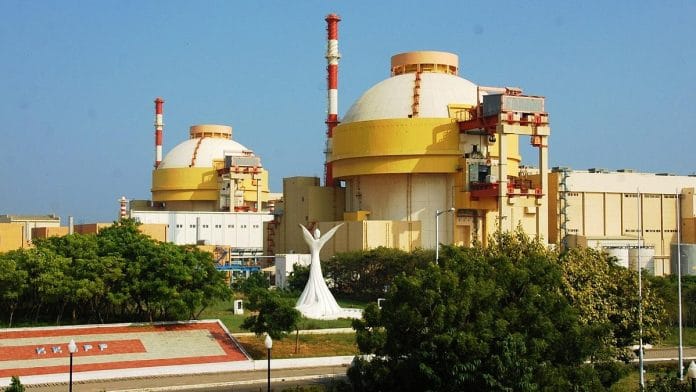India has made progress in solar energy in the last few decades. The action on nuclear power remains modest. As of March 2022, the Nuclear Power Corporation of India Limited was operating 21 reactors with an installed capacity of 6,780 MW, which accounted for 1.7 per cent of the country’s total installed capacity.
The Ministry of Power’s Central Electricity Authority expects a capacity addition of 6,600 MW from nuclear energy between 2027 and 2032, compared to 1,79,000 MW from solar and 49,000 MW from wind during the same period.
This article takes a dive into the trade-offs between nuclear and solar power on questions of safety, cost, and efficiency.
Is nuclear energy safe?
Many of us may remember the 9.0-magnitude earthquake that struck off Japan’s coast and the tsunami that followed. This proved to be a disaster for the Fukushima Daiichi nuclear plant that was powering 30 per cent of Japan’s electricity. The tsunami led to a failure of its power system that was important for cooling the nuclear reactor cores. This resulted in hydrogen explosions and partial meltdowns in three reactors. The radiation that was released from this incident prompted mass evacuations. This incident led to a rethink of nuclear power—Japan decommissioned 21 out of its 54 nuclear reactors. As of 2023, the share of nuclear power has come down to about 6 per cent. Countries such as Germany also withdrew from nuclear energy in the aftermath of the Fukushima disaster.
However, more than a decade has passed since the disaster. The pressure to decarbonise is upon us. The world has made significant progress in improving the safety of nuclear power plants. Earlier, reactors required active cooling systems, which meant that, in an emergency, both power and human intervention were required for cooling. Newer designs, including the Small Modular Reactors (SMR), are built to be “passively safe.” In other words, they are designed to shut down on their own in an emergency. There is also growing interest in floating nuclear power plants where the reactor is located at sea thus leveraging the cooling effect of water, making it safer. As of now, only one such floating nuclear plant exists in Russia, but interest in this technology continues to grow.
Besides engineering, there have been significant developments in the regulatory framework for nuclear energy, with countries building standards and safeguards to avert future disasters.
Nuclear energy’s safety profile has improved with advancements in both technology and regulation. Yet, the question of safety remains, especially owing to the possibility of accidents after a natural disaster, and the ongoing challenges of dealing with radioactive waste. The consequences of human error are also more severe in nuclear power, making high technical skills a prerequisite for safe operation.
Also read: Three sides of India’s nuclear security regime—and what more it needs
Is nuclear cost-competitive with solar?
The cost of nuclear power plants depends on the capital costs of setting up the facility, as well as fuel and other operating expenses. Estimates vary on how expensive nuclear electricity is. A report by Lazard suggests that the levelised cost of energy (LCOE), which includes construction, fuel, operation, and maintenance over the plant’s lifetime, for solar with storage ranges from $60-$210/MWh, while the LCOE for nuclear ranges from $140-$220/MWh, making nuclear a much more expensive option. These costs are approximations, as conditions in each country can be very different.
How would these play out in India? A 2020 joint report by the International Energy Agency and the OECD Nuclear Energy Agency shows that, in India, the LCOE for nuclear is $48/MWh and solar utility–scale costs $35/MWh.
However, the upfront costs for nuclear are much higher than for solar. Setting up a nuclear plant also takes more time, making it a difficult investment. Similarly, the operational costs for nuclear are also higher than those for solar. Further, nuclear energy is dependent on raw material, which makes it vulnerable to geopolitical events. In contrast, solar energy is immune to international events and price volatility in global markets. While the costs, over the lifetime of the plant, may equalise, the high upfront costs make nuclear a more difficult proposition in India. Furthermore, unlike Europe, which has limited solar opportunities, India faces no such constraints. The human capital required to generate solar power is also cheaper than that required for nuclear power.
Also read: 50 years of India being a self-reliant nuclear power. What the next govt should focus on
What are the advantages of nuclear power?
The advantage of nuclear power is that it is available 24/7 and has a capacity factor of almost 90 per cent. This means nuclear plants operate close to their maximum output over time, providing consistent and reliable electricity. This is not the case with solar, which is only available when the sun is shining, and therefore has a capacity factor of 15-30 per cent. Solar will, therefore, always require backup from coal or some other technology for baseline energy needs, as well as significant storage capacity. In contrast, nuclear plants can produce high-output power, making it ideal as an efficient source of electricity for large, densely populated cities. Further, nuclear energy produces zero carbon emissions, making it an important component of the strategy to achieve net-zero targets.
Private capital will assess these trade-offs before making investment decisions. Investors across the world are increasingly allocating resources toward both solar and nuclear energy. Regulators are addressing safety and liability concerns. However, the policy landscape for nuclear energy in India remains restrictive, which deters private sector involvement. While safety is paramount, easing regulatory constraints could unlock critical flows of private investment and foreign expertise.
Renuka Sane is managing director at TrustBridge, which works on improving the rule of law for better economic outcomes for India. She tweets @resanering. Views are personal.
(Edited by Aamaan Alam Khan)






